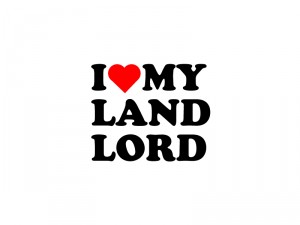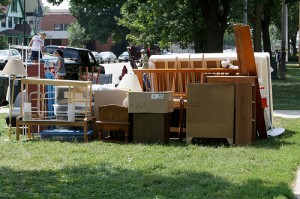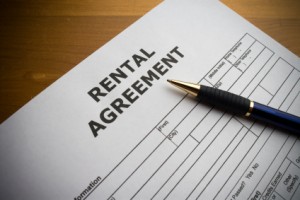Posted by Teresa on February 19, 2011 under Landlord Tips | 

Verify Before You Hand Over the Keys to a New Tenant
When a new tenant moves in, do you welcome them with open arms, or just hand over the keys? Great tenants are few and far between, and even good tenants make your life much easier. So why not show your appreciation and start the landlord/tenant relationship off right?
Lots of landlords we know present a new tenant with a welcome package of goodies. Some cost them little to nothing out of pocket—say, $10 – $15. Others keep it strictly business and include just the legalities.
If you choose the former, here are a few items to include in a welcome package that will make your new tenant feel right at home:
- A list of emergency phone numbers. This might seem old-fashioned when a simple call to 911 will fetch police, fire and ambulance. But your tenants also need to know how to get in touch with your preferred maintenance people in an emergency. Do include the numbers for your plumber, electrician and general maintenance provider, along with utility companies.
- A floor plan clearly indicating the emergency evacuation route, location of fire extinguishers and smoke alarms and emergency water shut-offs.
- Coupons for local businesses. Stop by the neighborhood pizza shop, dry cleaner, deli and other businesses that might love to have your new tenants for customers. See if you can strike a deal with the pizza shop for discounted gift cards and include one as a gift for move-in day.
- Bus routes, trail and bike maps. More and more tenants are ditching their cars for alternative forms of transportation. Make it easier for them to find the right bus, bike to work, or go for a walk or run on nearby trail.
- A few of life’s necessities, like toilet paper, paper towels and a few extra batteries for the smoke detectors. These low-cost items can really make a big difference when moving into a new place.
Remember, a small effort can actually go a long way to establishing a good relationship with your new tenants. And even if some don’t seem to appreciate it, you might be reaping unseen rewards in the form of fewer problems and happier tenants!
Posted by Teresa on February 16, 2011 under Landlord Tips | 
 Landlords and tenants wrestle with certain issues more than others. Security deposits, rent due dates, and wear and tear are a few that seem to pop up the most. What a landlord considers damage, a tenant might view as “normal wear and tear.” Conversely, a tenant may think water damage is the landlord’s responsibility, while the rental property owner thinks it falls under the umbrella of tenant obligations.
Landlords and tenants wrestle with certain issues more than others. Security deposits, rent due dates, and wear and tear are a few that seem to pop up the most. What a landlord considers damage, a tenant might view as “normal wear and tear.” Conversely, a tenant may think water damage is the landlord’s responsibility, while the rental property owner thinks it falls under the umbrella of tenant obligations.
Here is a guide to help settle which is which when it comes to wear and tear:
| Normal Wear and Tear: |
Tenant Damage: |
| Minor scratch in wood floor |
Gouges or pet scratches in wood floor |
| Carpet indentation from furniture |
Torn carpeting |
| Worn areas in flooring, such as in doorways |
Burns or stains in flooring |
| Dirt on walls and floors |
Cigarette or food stains on walls and floors |
| Minor indentations on walls |
Holes or gouges that require repair |
| Water stains in bathroom |
Water damage from not reporting leaking pipe |
| Surface dust or dirt |
Layers of dirt from not cleaning |
| Dusty window blinds |
Broken window glass |
| Slow drains due to normal use |
Plugged-up drains from misuse |
| Cracks in tile due to age |
Broken tiles from heavy objects being dropped |
| Worn parts on appliances |
Missing parts on appliances |
Clearly, there are limitations to a landlord’s responsibility, whether a tenant doesn’t take proper care of a rental unit or an accident occurs. For example, a tenant may not be totally at fault for his friend’s dropping a bowling ball on the tile floor, but when it happens to someone else’s property, he who lives there must be held responsible.
And if a tenant can’t be bothered to clean her apartment, the landlord is entitled to have it done for her when she moves out—and deduct the fee from the security deposit.
On the other hand, it’s always up to the property owner to perform routine maintenance, which can go a long way to preventing bigger problems, like clogged pipes, water damage and worn out appliances.
Posted by Teresa on February 12, 2011 under Landlord Tips | 
 As vacancy rates drop in many areas, landlords are increasingly phasing out incentives and enticements to attract tenants. It was not too long ago when you’d see banners for “One Month Free Rent” or “Free DVD With 1-year Lease” on apartment buildings.
As vacancy rates drop in many areas, landlords are increasingly phasing out incentives and enticements to attract tenants. It was not too long ago when you’d see banners for “One Month Free Rent” or “Free DVD With 1-year Lease” on apartment buildings.
Now, not only are those signs coming down, but rents are starting to climb as rental inventory drops and demand rises. How does a rental property owner determine what rent to charge? How do the changing conditions in your area affect the rent you can charge?
The obvious answer is to look at what the market will bear. Many landlords begin their research by checking the Fair Market Rent (FMR) for their area. FMR is the amount of money a property will lease for, based on variable factors like economic conditions, location, and local vacancy rates.
The U.S. Department of Housing and Urban Development (HUD) uses Fair Market Rent values to determine the eligibility of rental housing units for housing assistance, known as Section 8 payments. The values are designed to be high enough to ensure an adequate supply of rental units, but low enough to serve as many families as possible.
Once you’ve established the FMR for your area, compare it to what is being charged for similar unites. Check Craigslist.com, local advertising, and sites like ForRent.com, Rent.com, Rental.com and any local sites that cater to your city.
Don’t be tempted to set rent too high or too low for your properties. You are in business to make a profit—and while lower rents may keep your units full, if you’re not making money, you will not survive in the investment property business.
On the other hand, setting rents too high will almost guarantee that good tenants will pass up your property for similar amenities at a lower price. Still, when vacancies are low, you can away with charging a premium rent. Setting rent is a balancing act: keep an eye on the rental market at all times, and adjust your rents accordingly.
Resources:
http://www.huduser.org.
http://rentometer.com
Posted by Teresa on February 9, 2011 under Housing Trends | 
 Arizona state lawmakers have approved to send to the full state Senate a new law requiring landlords and tenants to share responsibility for bedbugs in rental units. Here’s how the proposed law shakes out:
Arizona state lawmakers have approved to send to the full state Senate a new law requiring landlords and tenants to share responsibility for bedbugs in rental units. Here’s how the proposed law shakes out:
Rental property owners will be required to:
- Keep their units free of bedbugs.
- Provide tenants a copy of the law, once passed, as well as with educational materials on bedbugs, including prevention and control measures.
- Arrange for a licensed pest control company to inspect a unit within seven business days of a possible bedbug problem.
- Start the process of mitigating the bedbugs in the rental unit within seven days of finding evidence of infestation.
Tenants are responsible for:
- Notifying landlords in writing or via electronic document of infestations.
- Providing access to their units for inspection and bedbug treatment.
- Complying with the bedbug mitigation protocol established by the pest control company is required. This includes pre- and post-treatment procedures, temporary evacuation of the unit and notifying within three days of recurrence.
Additional Requirements:
- Landlords are prohibited from knowingly leasing a bedbug-infested rental unit.
- Tenants are prohibited from moving bedbug infested materials into a rental unit.
- Only licensed pest control applicators would be allowed to treat bedbugs in multifamily housing.
- Tenants must receive written notification of mitigation treatment three business days or more before it begins.
Perhaps most important is the allocation of financial responsibility. According to the bill, while the landlord is responsible for pest control expenses when tenants comply with their obligations, the responsibility falls to a tenant if they fail to comply. In this case, not only are tenants responsible for mitigating the problem in their own unit, but also any surrounding units that become infested due to non-compliance.
This bill is one of the first we’ve seen that tackles the bedbug problem in rental units. And, it seems to be pretty fair to landlords. What do you think?
We’ll follow the bill as it progresses through the Arizona state Senate.
Posted by Teresa on January 19, 2011 under Landlord Tips | 
 The business of renting property is never perfect. It can be tough. Sometimes, it can be really tough. But today we’re going to focus on what landlords can do to make their properties better places to live. And who knows? These efforts can pay off in happier tenants, longer leases, and higher-quality applicants.
The business of renting property is never perfect. It can be tough. Sometimes, it can be really tough. But today we’re going to focus on what landlords can do to make their properties better places to live. And who knows? These efforts can pay off in happier tenants, longer leases, and higher-quality applicants.
- Your rental property is kid- and pet-friendly. While this doesn’t work for every property, it does make things easier for parents of two-and four-legged kids. Provide and enforce clear-cut rules, along with designated areas for kids to play and dogs to do their business, and you can make nearly everyone happy—even your tenants who prefer to keep rugrats and furballs at arm’s length.
- Your rental property is fun. Creating positive interactions between residents, through potluck dinners, book and movie exchanges, a game room, or picnics can go a long way toward creating a community. People who know their neighbors feel more safe—and are more willing to look out for each other.
- Your rental property is welcoming. While it is the law that you do not discriminate on the basis of race, religion, family status, disability, sex and other factors covered by the Fair Housing Act, you create quite a different feeling when you advertise that everyone is welcome. Print a statement of welcome to all people on your leases, add it to your signage and your advertisements, too.
- You provide excellent customer service. Great landlords remember that their tenants are their customers. Without them, there is no rental business. All landlords know the feeling of less-than-100% vacancy; try to keep it in mind when servicing your tenants.
- You strive to accommodate everyone. Providing closer parking for disabled is the law, but reserving a few close spaces for older tenants, who might not have an actual disability is just a nice thing to do. Providing secure storage for bicycles encourages their use, which is good for the planet and the health of your tenants.
- You treat your tenants with respect in every interaction and communication. Few people cannot tell when they’re being disrespected or on the receiving end of a condescending attitude. If showing respect is difficult for you, then leasing property might not be the best business to be in.
Being a great landlord is not just a nice way to conduct business—it IS good business! Happy tenants will stay longer, cause fewer problems and recommend your property to their friends, family and co-workers. Why not strive to be a great landlord?
Pre-screen all tenants as part of your standard application process. Background and credit checks will help ensure you rent to qualified tenants. For more landlord resources, including forms and information on tenant screening, turn to E-Renter.com.
Posted by Teresa on December 23, 2010 under Housing Trends, Landlord Paperwork and Forms, Tenant Credit Checks | 
 Short-term leases are becoming more popular in some areas of the country. One trend is that homeowners who sell a home are less willing to buy right away, so while they wait and see what the market will bring, they rent for a while. Another factor is the toll the economic crisis took on renters’ credit scores. Landlords are less willing to take chances on one-year leases, so often a month-to month or six-month lease is a great option.
Short-term leases are becoming more popular in some areas of the country. One trend is that homeowners who sell a home are less willing to buy right away, so while they wait and see what the market will bring, they rent for a while. Another factor is the toll the economic crisis took on renters’ credit scores. Landlords are less willing to take chances on one-year leases, so often a month-to month or six-month lease is a great option.
When the economy and job market are both doing well, the ideal situation for a landlord is a one-year lease with a strong tenant. But even though the rental markets across the country are starting to show improvement, many landlords are far from the ideal—and they still need to fill rental units.
When credit scores are less than perfect, and home sellers are knocking on your door, looking for short-term leases, it makes sense to adjust your lease terms from one-year to six-month or month-to-month.
Month-to-month leases mean that at the end of any month, the tenant can simply move—or the landlord can end the lease. Most leases require notice on each side, but if neither side ends the lease, it continues for another month.
7 Advantages of Short-term Leases:
- Your rental units could be occupied instead of empty
- Improved cash flow
- Possibility of higher rent negotiation
- Easier transition between tenants (less clean-up and maintenance)
- Larger pool of possible tenants
- You can get rid of a bad tenant more quickly
- For month-to-month leases, the rent can be adjusted at any time
Remember, no matter what the length of the lease, proper tenant screening is the most important step you can take prior to signing it. Conduct a thorough tenant credit check and background check and you’ll feel better about offering a lease to short-term tenants.
Posted by Teresa on December 14, 2010 under Landlord Paperwork and Forms, Landlord Tips | 
 Many tenants notify landlords of their plans to move at the end of a lease by mentioning it in passing. Others assume that, if they haven’t signed a new lease, the landlord knows they are moving and they don’t need to notify.
Many tenants notify landlords of their plans to move at the end of a lease by mentioning it in passing. Others assume that, if they haven’t signed a new lease, the landlord knows they are moving and they don’t need to notify.
It’s a good idea to require tenants to provide a written notice of their intent to move. Many states require it, and if you use a well-written lease, it probably does as well.
The Advantages of Written Notices
Requiring tenants to put their intentions in writing is a good idea for several reasons:
- It eliminates the mix-up that can occur with verbal notifications
- It keeps the landlord/tenant relationship more businesslike
- It may be state law
- Written notices leave nothing to the imagination
- You won’t forget the tenant’s move-out date, which can lead to problems
- You’ll have time to prepare the security deposit return or deductions
What to Include on a Tenant’s Notice of Intent to Vacate Unit
Use a simple form, either one you obtain online or one you create yourself. You can provide it to tenants at lease signing, although it’s not likely they’ll keep it around long enough to turn it in at the end of the lease. Many landlords provide a form to tenants 60 or 90 days before the lease is up, with instructions to return it within 30 days of the end of the lease, if they plan to move.
The form should include:
- The date the form was completed;
- The name of the landlord or property management company;
- The address of the rental unit;
- Legal language including: The undersigned Tenant (name) hereby gives written notice of intent to vacate the rental unit at (address) on (date);
- A statement that the tenant understands they are responsible for rent until the end of the current lease or the day they vacate the unit, whichever is later;
- A statement that in accordance with the lease, the landlord is allowed reasonable access with advance notice to show the rental unit to prospective renters or contractors;
- A line for the tenant to sign and date the form.
As you can see, a thorough tenant move-out form covers all the bases: the date of the move-out, the day the rent is to be paid through, and permission to show the unit or allow access to workers.
Landlords who want even more information can include a short survey on the form, asking why the tenant is moving and if there is anything that could have been done to keep him or her as a tenant. This type of feedback is extremely valuable!
Pre-screen all tenants as part of your standard application process. Background and credit checks will help ensure you rent to qualified tenants. For more landlord resources, including forms and information on tenant screening, turn to E-Renter.com.
Posted by Teresa on November 24, 2010 under Housing Trends | 
 According to a report on CNNMoney.com, home builders had a terrible month in October, with new home sales falling 80% from the top of the boom five years ago. Commerce Department figures show sales dropped to an annual pace of just 283,000, down 8.1% from September.
According to a report on CNNMoney.com, home builders had a terrible month in October, with new home sales falling 80% from the top of the boom five years ago. Commerce Department figures show sales dropped to an annual pace of just 283,000, down 8.1% from September.
Last October, the annualized sales rate was 430,000. This year’s figure represents a whopping 28.5% decline from 12 months ago. Experts had predicted 2010 sales in October to be around 314,000—and were surprised by the dismal showing.
The peak pace was set in July 2005, at 1.4 million sales, and despite attractive mortgage rates, sales remain sluggish as 2010 comes to a close. The total number of homes on the market has dropped 20% since October, 2009.
First-time buyers were more likely to jump into homeownership, without the burden of selling an existing home. Getting a mortgage is still a challenge, and many potential buyers are unable to obtain financing.
The chief economist for the National Association of Home Builders (NAHB) blames the lower home sales figures on a drop in the number of people forming households. Unemployment and the slow economy mean people are staying at home with their parents longer, moving in with friends, or not getting married.
Individuals who cannot get financing to buy a home, and those unwilling to risk taking on a long-term situation like homeownership in this shaky economy will continue to turn to the rental market. For many, renting continues to be a more viable option—especially with shorter-term leases. Landlords are responding by becoming more flexible with six-month or even month-to-month leases to accommodate changing needs.
Posted by Teresa on November 20, 2010 under Tenant Credit Checks, Tenant Screening & Background Checks | 
 When it comes to filling a rental vacancy, most landlords are happy to have several applications to choose from. But sometime, you don’t have a clear “winner” among your potential tenants. As the economy continues to slog along and unemployment shows no signs of easing up, it’s possible that the pool of potential tenants will just keep declining in quality.
When it comes to filling a rental vacancy, most landlords are happy to have several applications to choose from. But sometime, you don’t have a clear “winner” among your potential tenants. As the economy continues to slog along and unemployment shows no signs of easing up, it’s possible that the pool of potential tenants will just keep declining in quality.
What does a landlord do when the only applicants for a rental property have low income, no job, shaky references or no clear source of income?
The first thing to take a look at is each tenant’s credit history. If the applicants pay their bills on time, they will likely pay their rent on time. If all four have questionable credit checks, then compare incomes. For example, if Mary will be paying 2/3 of her income on the rent, but Jane makes enough to cover rent with just 1/3 of her take-home pay, many landlords would breathe easier signing a lease with Jane.
What about unemployed applicants? Landlords report they are seeing more applicants who report they are unemployed. Most receive unemployment benefits, but as everyone knows, they run out. Is an unemployed applicant a definite “no?” Not for some landlords. Devin says he checks other sources of income, such as child support and disability payments. If unemployment is a potential tenant’s sole source of income, he will typically deny the lease application.
For potential tenants who are self-employed, it’s not always easy to prove income. Ask for tax returns, bank statements, and several references—including, of course, former landlords. Money in the bank is a good indicator that the tenant lives below his or her means and knows the value of having cash reserves. And, note that the income reported to the IRS may or may not be indicative of the individual’s true income.
When landlords feel pressured to sign a lease with a less-than-perfect credit risk, it’s sometimes a little less painful to make it a six-month term rather than a full year’s lease. If the rent has been paid on time, you can always extend it for another six months. If not, it’s possible that the pool of potential tenants will have improved in six months.
Posted by Teresa on November 16, 2010 under Landlord Paperwork and Forms, Landlord Tips | 
 If you’re a new investment property owner, starting out with all your paperwork in place is a must-do. That means compiling a lease agreement before you show your rental property to a prospective tenant—no matter how badly you want or need to rent it.
If you’re a new investment property owner, starting out with all your paperwork in place is a must-do. That means compiling a lease agreement before you show your rental property to a prospective tenant—no matter how badly you want or need to rent it.
Depending on where you live or where your rental property sits, you’ll have specific requirements unique to that state or locality. Be sure to familiarize yourself with the requirements of your state. But in general, the same provisions apply to most residential lease agreements no matter where the property is located. Most important: you need to be sure your lease agreement protects your property, your other tenants, and your business and personal resources.
Here’s a handy list of important provisions to include in a lease agreement:
- Legal Description of the leased premises: Be thorough. Include address, apartment number, city, state and zip code
- Term of Lease, including starting and ending date, with a provision to terminate early in accordance to provisions of the lease;
- Use and Occupancy: Explain how the property may be used (i.e. “for residential purposes”) and a list of names of authorized occupants.
- Rent Payment: State the amount of the rent, how it is to be paid, and penalties for late payments and insufficient funds. Consider a statement that no partial rent payments will be accepted (to avoid any problems if eviction becomes necessary).
- Security Deposit: state the amount of the deposit due upon signing the lease, as well as conditions for return of the security deposit.
- Default: Explain events of default and remedies.
- Utilities: State who pays for which utilities, including gas, telephone, cable, internet, electricity, water, sewer and trash pickup.
- Covenant of Quiet Enjoyment: This explains that the tenant, upon fulfilling his or her obligations under the lease, may peaceably and quietly enjoy the premises without interference by the landlord or a representative thereof.
- Assignment or Subletting: State whether or not the tenant is allowed to assign the lease or sublet the property, and if so, set the conditions under which they may.
- Pets: State whether or not pets are allowed and any restrictions related to type, size, breed, number, etc. Also include the amount of any required pet deposit or fee and conditions for return at the end of the lease.
- Maintenance, Damage and Alterations: States what maintenance the property owner is responsible for, what the tenant is required to do to maintain heating and plumbing systems, when routine maintenance inspections will be conducted, conditions under which the property owner may enter the unit for emergency repairs, and what alterations (paint, for example) are allowed.
- Insurance: Explain what type and level of renter’s insurance is required, if any.
- Abandonment: Defines what may be considered abandonment of the property by the tenant, and the landlord’s rights when it occurs.
- Right to Enter Premises: States when and under what circumstances the property owner or representative will be allowed to enter the rental unit, i.e., number of hours or days of notice.
Other notices, indemnities and covenants are likely to be required in a particular state or by your attorney. It’s always best to have legal counsel review your residential lease prior to using it.
Any forms or information provided by E-Renter USA is not intended to replace legal advice. You are advised to consult an attorney in your area, and to check all local and state regulations.










